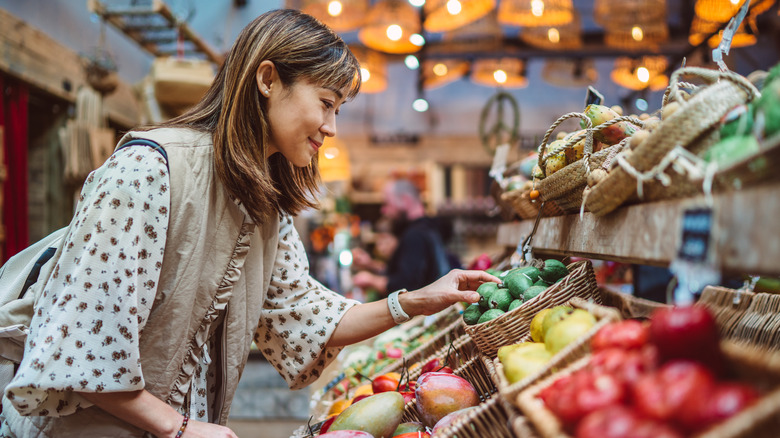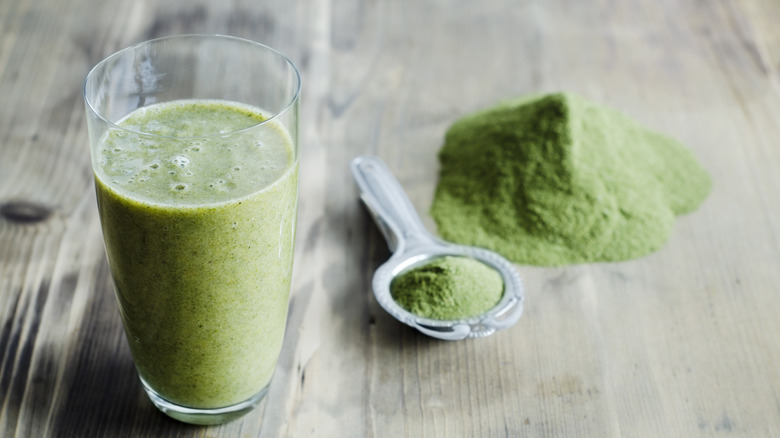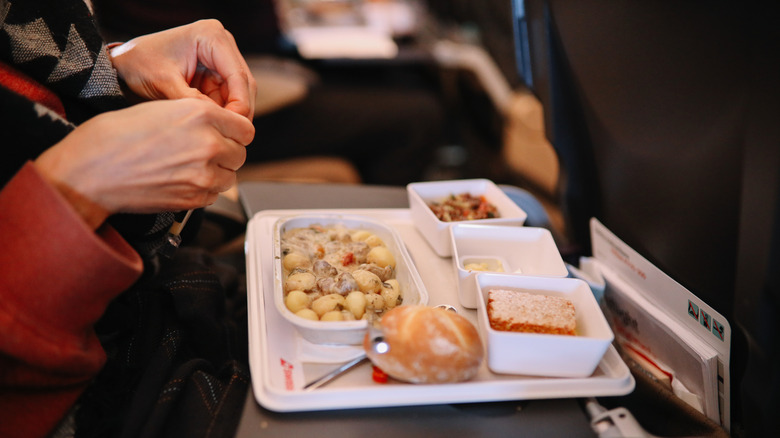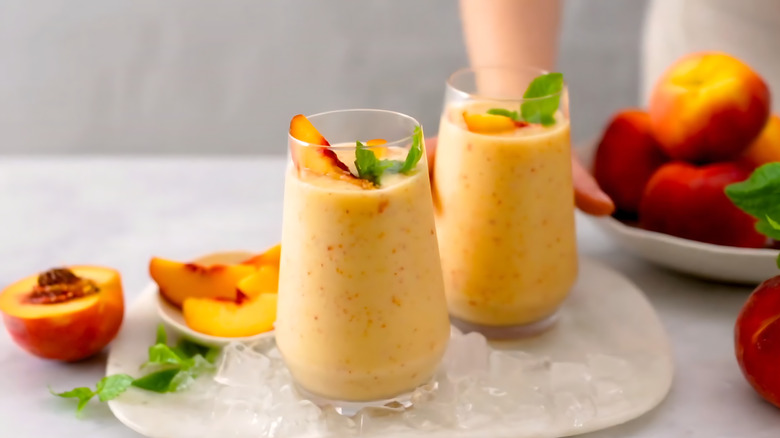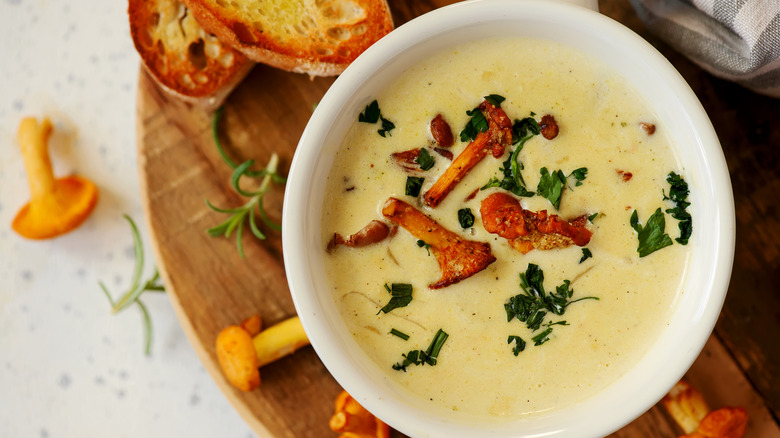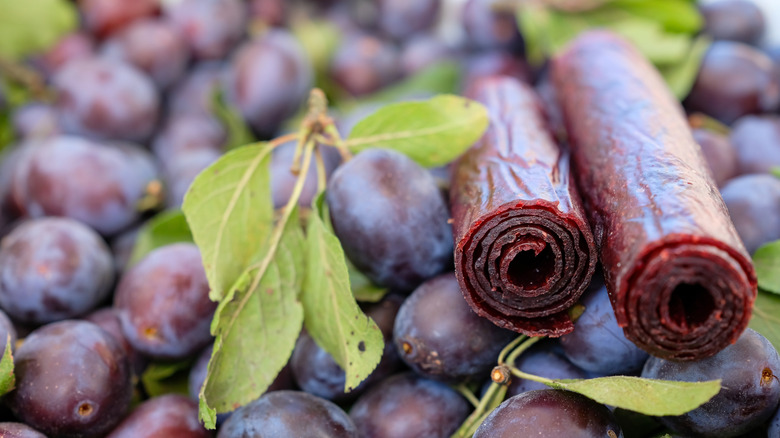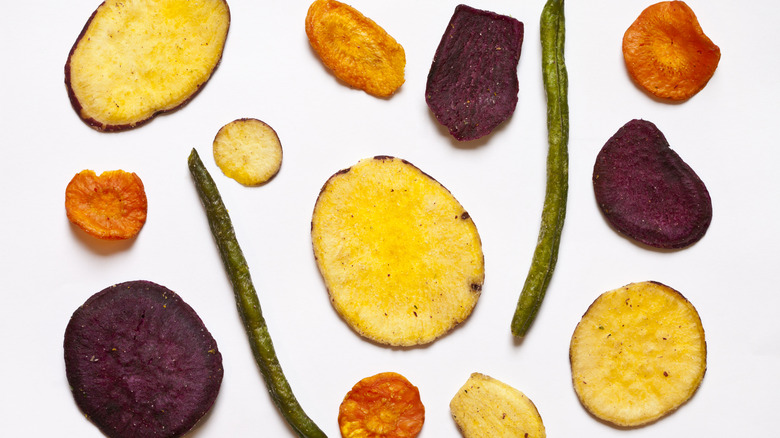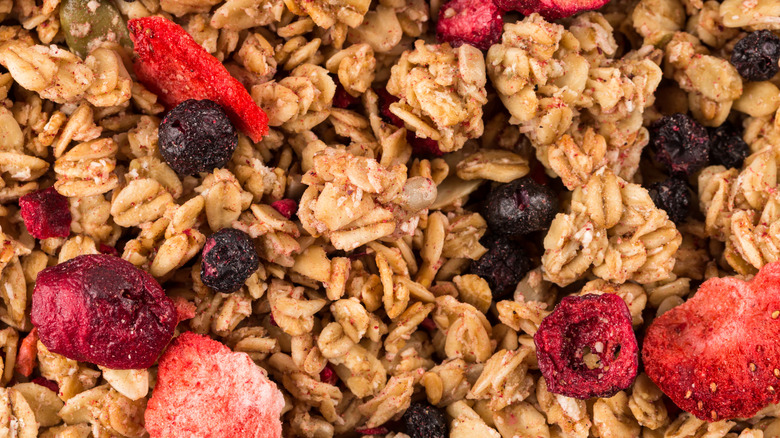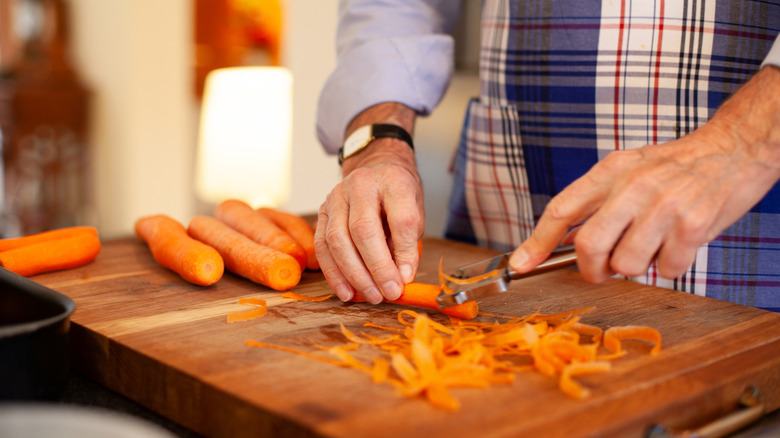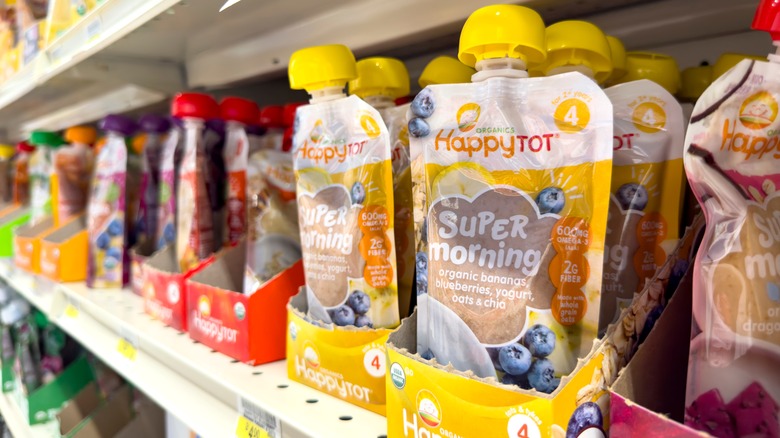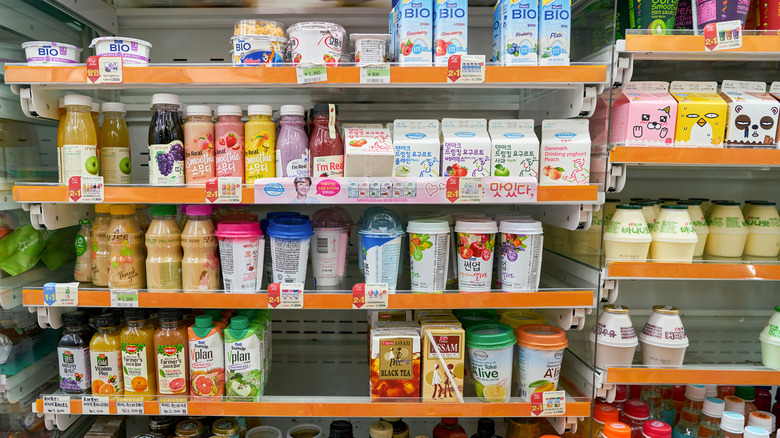The 11 Best Ways To Sneak In More Fruits And Vegetables While You're Traveling
We may receive a commission on purchases made from links.
The act of eating is simultaneously one of the most enjoyable and important parts of going on vacation. In fact, your vacation might be centered around eating, especially if you are touring apple orchards on your fall getaway to Vermont or relishing the wineries of Napa Valley. When traveling to new lands, you may encounter flavors you have never even heard of. From herbs and spices, to fruits and vegetables, to meats and seafoods, a "normal" diet looks quite different in each part of the world. Whether you tend to lean back on tried-and-true comfort food from back home or go all-out eating new-to-you foods, it is critical that you incorporate an adequate amount of fruits and vegetables into your diet while on vacation.
Although it can be easy to eat a carb-heavy diet while traveling, it can leave you feeling lethargic and craving fresh food. In fact, experts recommend you eat two servings of fruits and three servings of vegetables per day. The same is true while traveling; fresh produce is packed with nutrients and antioxidants, and fiber can actually help fight seasickness on your next cruise and reduce bloating while flying. At the same time, access to fruits and vegetables may be difficult in a foreign destination — whether because of safety concerns, language barriers with vendors, or perishability. This guide will help you learn how to navigate various challenges to ultimately include more fruits and vegetables in your diet in ways that you will actually enjoy.
Choose accommodations with well-equipped kitchens
Rental properties with well-equipped kitchen can be game changers when it comes to eating nourishing foods on vacation. Even if you plan on making just one meal a day, you have the potential to pack plenty of fiber into that singular dish. For instance, toss together a large salad at the beginning of your vacation and eat from it for the rest of the week, setting aside different toppings like raisins, canned beans, and apples to incorporate more variety into each meal.
What should you look for in a kitchen when booking a rental property? First, run through the listed amenities. Make sure there are dishes, a refrigerator, and pots and pans. Sometimes, cooking oil is listed; if not, bring your own. In case a barbecue is provided, ask yourself whether you will really have time to use it. Next, check the reviews. Frequently, previous guests will let you know if the kitchen was subpar, sometimes even mentioning specific items that were missing. Finally, consider what kind of stay it is; if you are sharing the house with a family who lives there full-time, your odds of a fully stocked kitchen might be better.
Not only will cooking your own meals give you more agency over how many fruits and veggies you are consuming each day, but it will also help you save a few bucks. Not to mention, if your accommodations feature a lovely view, enjoying a meal at home is an excellent way to ensure that you are fully appreciating what your rental unit has to offer.
Tap into the power of powders
Powdered fruits and veggies are all the rage these days. Marketed for daily use, they aim to supplement consumers' diets by providing vitamins and minerals essential to overall health. Some of these nutrients can be otherwise difficult to consume in adequate amounts. For instance, a vegetarian might need assistance in meeting their B vitamin quota, while women of reproductive age have a greater tendency to lack enough iron. Powdered supplements, which feature nutrient-packed ingredients like wheat grass, mushrooms, spirulina, carrots, and spinach, can help fill in these gaps.
Many commercial powders feature more than just vitamins and nutrients. Athletic Greens' AG1, for instance, includes vitamins, minerals, pre and probiotics, adaptogens, antioxidants, and even digestive enzymes, all conveniently proportioned into individual servings. Meanwhile, KOS' Reds Superfood is fruit-based and contains a signature blend to support digestion alongside two other signature superfood blends. You can mix these powders into water, smoothies, and even mocktails.
When traveling by plane, pack these powders in your checked luggage to reduce the chances of them being confiscated. TSA requires you to place powders greater than 12 ounces in a separate bin and warns that they may need to be opened for further screening. Not a fan of powders, or afraid of having them confiscated? Grüns super green gummies may be just right for you.
Don't rely on in-flight service
There's a good reason why Gordon Ramsay won't eat airplane food. Fortunately, many airports offer healthy, appealing options. Unfortunately, they usually come at a hefty price. While you can typically find refrigerated foods like fruit cups, sandwiches, and crudités at shops such as Hudson Booksellers, these items tend to be expensive. In fact, fresh items like salads and fruit-filled parfaits will generally carry a higher price tag than bagels and chicken nuggets no matter where you shop.
You'll therefore want to breeze through all your options as you walk through the airport to determine the most economical, tasty, and nutritious choices. You may find them at a vending machine like Farmer's Fridge, which offers salads, chia puddings, grain bowls, trail mix, and more. Impressively, each Farmer's Fridge meal, from the green goddess salad to the Thai noodle bowl, packs in a complete serving of fruits and vegetables.
Of course, you can always carry along your own snacks and meals. Avoid bananas, which can easily become bruised and punctured, as well as pretzels, which can quickly turn into dust. Instead, try tucking away an apple, a stick of fruit leather, or a burrito packaged in a hard plastic container.
When packing, plan ahead and consider whether you will need sustenance after your flight concludes. If you expect to wait in long lines for customs and immigration, for example, or if you will be continuing to travel by car for several more hours, make sure you have healthy food on hand.
Start your day with a smoothie
As opposed to starting your day with juice or coffee, both of which lack fiber, get off on the right foot with a nutrient-dense smoothie. The presence of fiber helps regulate your blood sugar levels, and it also influences satiety, helping you feel fuller for longer.
Many coffee shops offer a selection of smoothies, as do fast food chains like McDonald's. Given that many of these will be full of added sugars and artificial flavors instead of real fruits, however, your best bet is to make your own. Invest in a high-quality portable blender and never have to worry about finding a smoothie shop or locating a blender at your Airbnb again. Swing by the grocery store at the beginning of your trip to pick up both fresh and frozen fruits, and have fun experimenting with local produce. Shopping locally at a farmers market is one of the best ways to avoid sneaky expenses on your trip to Hawaii. Bonus tip: Pack your favorite protein powder to make it a more well-rounded meal, and consider adding a serving of powdered greens or fruits as discussed earlier.
If you find yourself without a blender, however, don't fret. Wellness-oriented smoothie shops and food counters at some grocery stores like Whole Foods are likely to serve delicious and nutritious smoothies with real fruits and vegetables. If you are staying at a tropical resort, you may have no trouble at all finding a smoothie packed with local produce.
End your day with soup
While it is relatively simple to pick up a ready-to-eat banana or orange from a grocery store, most vegetables require extra steps before they are able to be consumed. From destemming and peeling to dicing and sauteing, preparing vegetables may not appeal to you while on a relaxing vacation. That's where soup comes in.
The simplest soups do not require you to do much more than wash and boil your vegetables before blending them into a puree. Some recipes, such as clear vegetable soup, do not even require blending. Of course, for the tastiest soup, you may need to complete a few additional steps, such as creating a mirepoix with onions, carrots, and celery or a roux with flour and butter. If you are staying in one place and you have access to a refrigerator, you can easily make enough soup to last your entire vacation, making it well worth the effort. Make sure to pick up a packet of croutons at the grocery store to make it a more filling meal.
Practically every cuisine includes some variation of vegetable soup, from Italy's minestrone to Portugal's caldo verde, so you won't need to look far when dining out. Finally, don't fall into the trap of thinking that soup is just for cold weather; switch it up with a cool gazpacho when vacationing somewhere warm.
Chomp into fruit leather
Several brands of fruit leather are available for purchase in the U.S. These aren't the Fruit Roll-Ups you devoured as a kid, but rather, minimalistic and nutritious snacks that folks of all ages can enjoy. For instance, the apple-pear variety of BEAR fruit rolls are a great source of fiber and only contain the two ingredients that are its namesake: Apples and pears. That's It fruit bars are similarly streamlined in ingredients and rich in fiber.
Fruit leather is a breeze to make at home and allows customization as per your preferences. All you need to do is puree your fruit of choice before pouring it onto a parchment-lined baking sheet and sticking it into a preheated oven (or dehydrator) until firm. You don't even need to peel fruit like apples and pears; just wash them well, and reap the benefits of additional fiber. Note that you may want to cook your fruit on the stovetop first to help kill any unwanted bacteria. Fruit leather can last about a month unrefrigerated, so you do not need to stress over making it during the last few hours of packing.
Here are a few extra tips if you plan to make your own fruit leather. Adding lemon or lime juice to the puree can help make both the flavor and the color of your fruit jerky more vibrant. Similarly, you can sprinkle in spices, herbs, and powders like cinnamon, nutmeg, ginger, basil, cacao, and vanilla for a tasty twist. Finally, experiment with different fruit combinations, like papaya and kiwi or banana and mango.
Pack dehydrated vegetables
Purchase or make your own dehydrated veggies before leaving. Once you are on vacation, you can add them to soups, pasta sauces, stews, and omelets. You can purchase dehydrated vegetables in some grocery stores and online, from brands like Augason Farms and Harmony House. To rehydrate vegetables, simply simmer them in water for 10-15 minutes or soak them for a few hours. Water-rich vegetables like zucchini, tomatoes, and bell peppers are some of the easiest to rehydrate, while ingredients like potatoes and beans can require longer to rehydrate. For vegetables like kale and sweet potato, you may not even want to rehydrate them at all, instead enjoying them as chips.
If you own a dehydrator, drying vegetables is quite simple. You'll just need to wash, blanch, slice, and dry them at 125 F until crispy. Exceptions to the rule are vegetables like bell peppers and onions, which don't require the initial step of blanching. Once your vegetables are fully dry, package them in Ziploc baggies or vacuum seal them in plastic to extend their shelf life. They will last months, and even years, depending on the storage method.
Take it one step further and prepare a lightweight, nutrient-dense, and easy breezy meal worthy of being eaten on vacation: Make a batch of soup and dehydrate it before leaving. It can make all the difference when you arrive at your accommodations exhausted after a long day of travel.
Add dried fruit to trail mix, granola, and muesli
You can purchase trail mix, granola, or muesli from a grocery store at your destination, or you can pack your own. Homemade versions offer many benefits; they are generally lower in sugar and more cost-effective, and you can tailor recipes according to dietary needs and personal preferences. Don't forget to take your destination into account: For instance, if you are headed to the beach or somewhere hot, you'll want to avoid trail mixes that contain chocolate, which can easily melt. You might also find yourself craving a tropical granola featuring ingredients like macadamia nuts and dried banana. Conversely, if you are traveling somewhere cold, opt for warming ingredients like cinnamon, walnuts, and maple syrup.
In fact, recipe variations are endless. Raisins are a classic ingredient in all three dishes, but don't be afraid to get innovative with dried fruits like coconut, pineapple, peaches, apricots, and blueberries.
Once you have added your dried fruits, you have many options for how to enjoy these mixtures. You can soak muesli, grated apples, and yogurt in milk overnight for a refreshing Bircher muesli breakfast. You can sprinkle trail mix into a steaming bowl of oatmeal for added texture, flavor, and nutrition. Or, you can layer your granola into a fruit and yogurt parfait for breakfast or dessert.
Consider sanitation
Euphemisms like "Delhi belly" and "Moctezuma's revenge" refer to travelers' diarrhea, a kind of gastrointestinal infection you should never underestimate. While locals may be accustomed to the bacteria, viruses, and protozoa commonly found in their food supply, your immune system is unlikely to be up to par in a foreign land where malignant microbes abound. For that reason, you will need to exercise extreme caution when consuming fruits, vegetables, and beverages in destinations like Asia, Latin America, Africa, and the Middle East.
After purchasing produce in areas where travelers' diarrhea is prevalent, first wash it with bottled water (not tap water), then peel it. In fact, you should favor fruits and vegetables that can be peeled, such as apples, carrots, bananas, and potatoes. It may be best to avoid salad greens altogether, as they can be difficult to thoroughly wash. Similarly, heavily textured vegetables like cauliflower and broccoli may not be ideal, unless you plan to boil or cook them over high heat.
Don't forget to be cautious when it comes to beverages as well. Coffees and teas are not always brought to boiling point, and smoothies are not always prepared with potable water. Make sure the bottles you purchase are properly sealed, proving that they have not been illegally refilled with contaminated water.
Squeeze your fruits and veggies
You may know it as "baby food" or think about serving it only to toddlers and small children, but squeeze packs of pureed fruits and vegetables are perfect for traveling adults as well. A plethora of shelf-stable options exist, which can come in handy when you are planning an affordable vacation to a place like Disney World. For instance, Noka superfood fruit smoothie pouches contain fruits like blackberries and pineapple, are rich in vitamins and minerals, and even feature 5 grams of protein each thanks to the inclusion of brown rice protein and flax seeds. Of course, you can always go back to the basics with a squeeze pack of applesauce.
To incorporate more vegetables into your diet, try eating Serenity Kids organic veggie purees. Flavor combinations like butternut squash and spinach help pack more nutrients into each pouch, and you can add them to soups and sauces if the thought of sipping them directly makes you queasy.
If you prefer to make your own purees and are able to keep them refrigerated, consider investing in single-use or reusable silicone pouches. You can freeze your purees weeks in advance, then keep them in a cooler during your next road trip. Add powdered fruits or greens to the mix for an extra boost of nutrition, as well as any spices you enjoy. You can even make nourishing, single-serving dessert pouches by blending together banana, dates, peanut butter, and cocoa powder.
Don't underestimate convenience stores
For many people, one of the most exciting aspects of visiting a new destination is tasting its unique array of local flavors. Learning about a new cuisine helps ground you in the cultures and geographies that shape it, whether it's prickly pear in the American southwest or pandan in Southeast Asia. You don't necessarily need to go to a grocery store, though, to find nourishing foods while on vacation.
If you are on the road or short on time, try your luck at a convenience store, where you can head to the refrigerated aisle for your best chances of finding fruits and vegetables. Many convenience stores carry ready-made smoothies, juices, and drinkable yogurts that feature local produce, like guava, mango, taro, and aloe vera. Vegetable juices, including green juices, are also common. Additionally, you can browse through the store's selection of packaged snacks, where you might find baked vegetable chips and dried fruits, as well as its canned goods section for preserved fruits and vegetables alike.
Before filling your shopping basket to the brim, take a moment to read the nutrition labels and ensure that what you are buying contains real fruits and vegetables. Some products may only contain flavoring agents and no produce at all.
